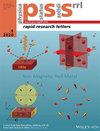Fe2O3 纳米粒子的纳米结构修饰:增强磁性的碳涂层
IF 2
4区 物理与天体物理
Q3 MATERIALS SCIENCE, MULTIDISCIPLINARY
引用次数: 0
摘要
本研究探讨了通过碳涂层进行纳米结构修饰来增强 Fe2O3 纳米粒子的磁性能。采用溶热法合成了 Fe2O3 和碳包覆的 Fe2O3 纳米粒子。对其结构、形态、光学和磁学特性进行了全面分析。结果表明,碳包覆后的颗粒尺寸明显减小,有效地缓解了团聚现象。此外,碳涂层纳米粒子的矫顽力、剩磁和饱和磁化率都有大幅提高,表明其磁性比未涂层纳米粒子更好。这种增强归因于碳涂层防止了纳米颗粒表面的自旋错位,以及由于颗粒尺寸减小而形成的独特磁畴。观察到的改进强调了碳涂层在定制 Fe2O3 纳米粒子的磁性能方面的有效性,可应用于磁性器件和生物医学系统,如磁性热疗和药物输送系统,在这些应用中,精确控制磁性行为至关重要。本文章由计算机程序翻译,如有差异,请以英文原文为准。
Nanostructural Modification of Fe2O3 Nanoparticles: Carbon Coating for Enhanced Magnetic Behavior
In this study, the enhancement of magnetic properties in Fe2 O3 nanoparticles through nanostructural modification via carbon coating is investigated. Fe2 O3 and carbon‐coated Fe2 O3 nanoparticles are synthesized using the solvothermal method. Structural, morphological, optical, and magnetic properties are comprehensively analyzed. The results demonstrate a significant reduction in particle size upon carbon coating, effectively mitigating agglomeration. Furthermore, carbon‐coated nanoparticles exhibit substantial enhancement in coercivity, remanence, and saturation magnetization suggesting improved magnetic behavior in comparison to their uncoated counterparts. This enhancement is attributed to the prevention of spin misalignment at the nanoparticle surface by the carbon coating, as well as the formation of distinct magnetic domains due to the reduced particle size. The observed improvements underscore the effectiveness of carbon coating in tailoring the magnetic properties of Fe2 O3 nanoparticles for applications in magnetic devices and biomedical systems, such as magnetic hyperthermia and drug delivery systems, where precise control over magnetic behavior is crucial.
求助全文
通过发布文献求助,成功后即可免费获取论文全文。
去求助
来源期刊

Physica Status Solidi-Rapid Research Letters
物理-材料科学:综合
CiteScore
5.20
自引率
3.60%
发文量
208
审稿时长
1.4 months
期刊介绍:
Physica status solidi (RRL) - Rapid Research Letters was designed to offer extremely fast publication times and is currently one of the fastest double peer-reviewed publication media in solid state and materials physics. Average times are 11 days from submission to first editorial decision, and 12 days from acceptance to online publication. It communicates important findings with a high degree of novelty and need for express publication, as well as other results of immediate interest to the solid-state physics and materials science community. Published Letters require approval by at least two independent reviewers.
The journal covers topics such as preparation, structure and simulation of advanced materials, theoretical and experimental investigations of the atomistic and electronic structure, optical, magnetic, superconducting, ferroelectric and other properties of solids, nanostructures and low-dimensional systems as well as device applications. Rapid Research Letters particularly invites papers from interdisciplinary and emerging new areas of research.
 求助内容:
求助内容: 应助结果提醒方式:
应助结果提醒方式:


